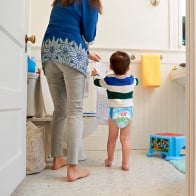Cautious
Helping Your Cautious Child Know When To Go To The Bathroom
18 Jan, 2023
3.5 min. Read
Your careful child thrives on structure, and enjoys keeping track of his successes. A timer is a great way to provide the consistency that’s so important to your process-oriented kid. You can also create a sticker chart together, so he can easily see his progress. Create a Sticker Chart with your methodical child. Hang the chart on the wall in the bathroom at your child’s eye level, and let them pick a small sticker to put on the chart every time they’re successful on the potty. Don’t make it too difficult to get a sticker; taking steps in the right direction is all that matters. Stickers are most effective when used as an immediate positive reinforcement rather than as a goal to save up for later. That’s because toddlers don’t have a solid sense of time, yet. Have your process-oriented kid review the stickers later with family members and friends to show off their progress.
Giving your careful child opportunities to practice the process when there’s nothing to wipe away can make them confident in wiping when there is actual pee or poop to clean up. “Let’s practice wiping so you’re ready to try once you’ve actually gone in the potty. We always put our toilet paper into the potty or toilet when we’re finished so it can flush away with the pee or poop!”
Teach your cautious child to continue wiping until nothing comes off on the paper. Remember that if your child is a girl, it is important for her to learn to wipe from front to back. If your child puts something into a potty chair, work together to deposit it into the toilet and clean out the potty. This is part of the potty routine that your careful child will want to learn about, given their natural need to know all there is to know about the potty. If your kid wants to help in a way that will still be hygienic, let them. If they aren’t showing interest, however, don’t force the issue.
- “Great job putting something in the potty! How many stickers do you have on the chart now? Let’s count together.”
- “Grandma and Grandpa are coming over soon. Would you like to tell them all about how you got your stickers today, and show them your chart?”
- Remember to remind your kid to feel what their body is saying, and check their Pull-Ups® training pants regularly. “Remember to pay special attention to when your body is telling you it has to go. When you feel that really tight feeling in your belly, that’s the time. Tell me right away so we can make it to the potty and keep your fading graphic there!"
Giving your careful child opportunities to practice the process when there’s nothing to wipe away can make them confident in wiping when there is actual pee or poop to clean up. “Let’s practice wiping so you’re ready to try once you’ve actually gone in the potty. We always put our toilet paper into the potty or toilet when we’re finished so it can flush away with the pee or poop!”
Teach your cautious child to continue wiping until nothing comes off on the paper. Remember that if your child is a girl, it is important for her to learn to wipe from front to back. If your child puts something into a potty chair, work together to deposit it into the toilet and clean out the potty. This is part of the potty routine that your careful child will want to learn about, given their natural need to know all there is to know about the potty. If your kid wants to help in a way that will still be hygienic, let them. If they aren’t showing interest, however, don’t force the issue.













